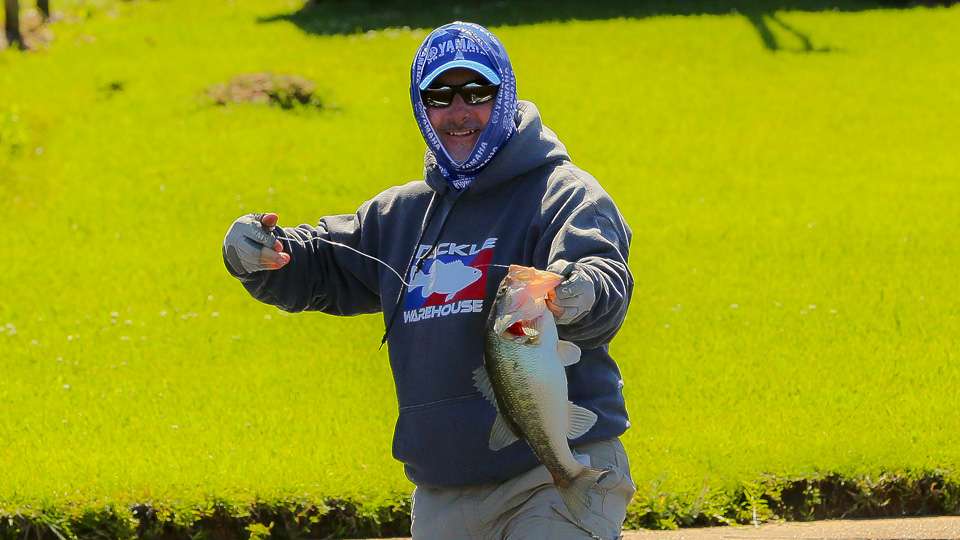
Plans for your fishing day got washed away with a nasty storm and lots of rain. All is not lost. You have another day off to get back out and go fishing.
Where to begin?
Twelve of the sport’s top pros faced that scenario on Ross Barnett Reservoir at the Academy Sports + Outdoors Bassmaster Elite at Ross Barnett. Day 4 got cancelled due to stormy weather. Championship Sunday became Championship Monday.
The storm passed, the skies cleared, the temperature dropped and the wind continued to blow. Classic post-frontal conditions, for sure.
When faced with that scenario the choices are starting all over again, or picking up where you left off on the last trip. Here is how the pros deal with that scenario, and specifically what they did on Ross Barnett. Take their advice and spend more time fishing instead of pondering where to begin.
Bobby Lane: Don’t over think it
“The process begins by going with your instincts,” said Bobby Lane Jr. “Don’t waste time over thinking where the fish might be.”
Defined, that means being open to fishing new water.
“If the bass aren’t biting where they previously did, then it’s because the weather doesn’t have them fired up,” he added, of the commonality occurring in post-front situations.
“Use a few key lures, confidence lures, to help get back on track,” he added.
“At Ross Barnett I used a swim jig, flipping jig and frog, as my confidence baits.”
The takeaway is relying on familiar, proven lures for your lake that can help instill confidence when faced with fishing new water.
Ish Monroe: Go fishing
“Just go fishing” is a relative term interpreted by the pros as keeping things simple.
“I don’t get too worried about the weather, try to over-analyze what I can’t control,” said Ish Monroe.
Doing so loads up the mind with too many choices.
“I have a fresh mind, open attitude and can make better decisions.”
Monroe took that approach on the cancelled Day 4. He avoided getting distracted by giving his body and mind a break.
Kevin VanDam: Fish the conditions
“In post-front conditions it’s all about realizing the bass are more sluggish,” said Kevin VanDam.
VanDam avoided much of the post-spawn funk on Ross Barnett by moving his game plan into the Pearl River.
Wind, rain and overall turbidity turned the world upside down for the main lake bass. The river population was less affected. Those bass were more acclimated to changing conditions in springtime.
VanDam recognizes that river fish move based on prevailing conditions, namely avoiding the muddiest water after a storm.
“Wind and current create mud but it also pulls cleaner water out into other areas,” he noted. “So fishing a river is not always such a gamble as trying to hunt and peck on a larger main lake.”
In VanDam’s case the move worked. Rainfall was minimal in his chosen area of the river. With heavier rainfall, and runoff, he would have avoided the river.
Jonathon VanDam: Fish on the fly
“I like to keep an open mind and make adjustments on the fly,” said Jonathon VanDam.
VanDam also fished the Pearl River in favor of the more dependable fishing conditions.
“River systems are subject to change, but you can also eliminate unproductive water easier, and faster.”
Choices are narrowed simply because of the size of the river compared to the main lake.
Mark Menendez: Year rounders
Mark Menendez fished a long stretch of riprap along the dam at Ross Barnett Reservoir. A dependable, year-round population of bass was the reason why.
“Those fish live on the dam year-round, and a quantity of fish is available that replenishes itself every day,” said Menendez. “I didn’t have to worry about running around the lake trying to find new fish.”
That is wise advice for the average angler. Focusing on a reliable area with a year-round population of bass. Fundamentally, that is an area that supports the bass population year round with habitat, depth and food. Examples are backwater sloughs, lakes, river systems and riprap shorelines.
Fred Roumbanis: Read the water
Fred Roumbanis arrived at the launch ramp nearly two hours prior to takeoff on Championship Sunday. An early morning caffeine rush was not the reason.
“I wanted to see for sure how the wind was blowing across the lake, see for sure how it set up for fishing conditions,” he explained.
Roumbanis knew ahead of time by seeing wind direction and velocity from a weather app on his smartphone. The smart move was seeing it in real time.
“My pattern was heavily influenced by wind, so being in tune with the environment was important,” he added.
The takeaways are nothing replaces time on the water. That’s a good thing when you just want to go fishing, right?

